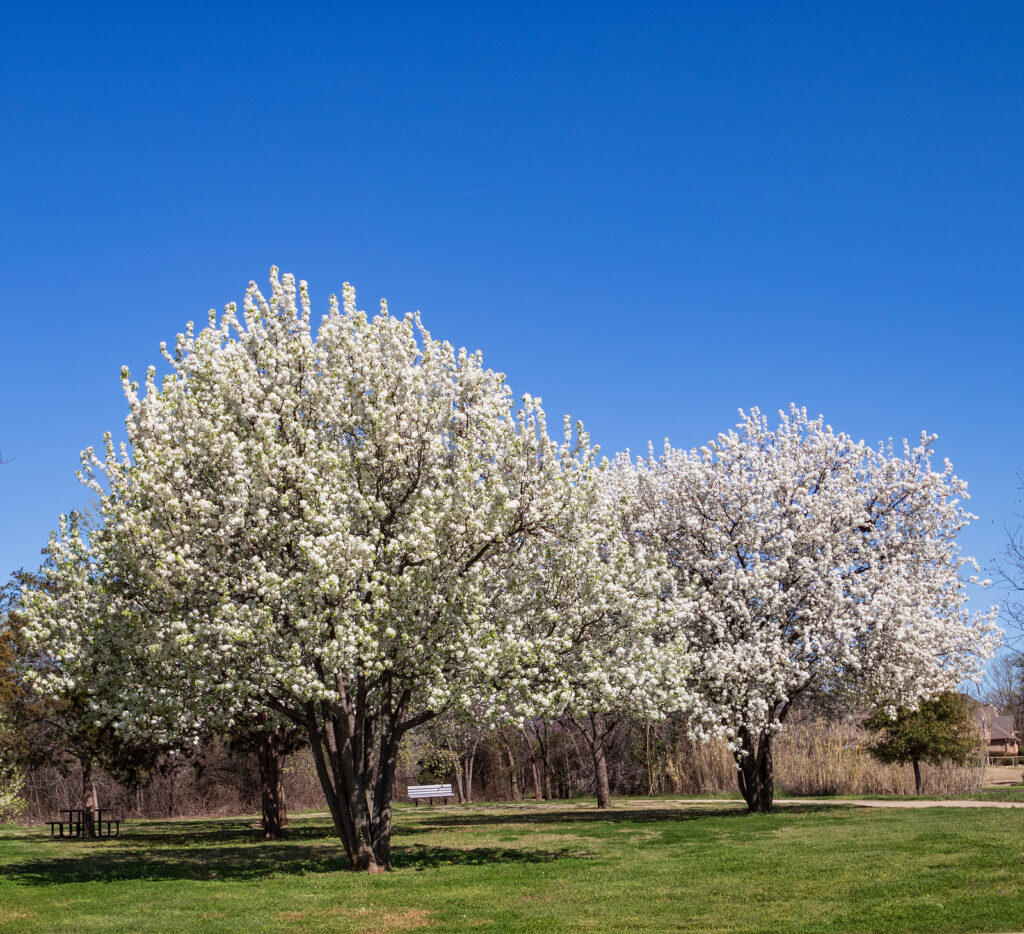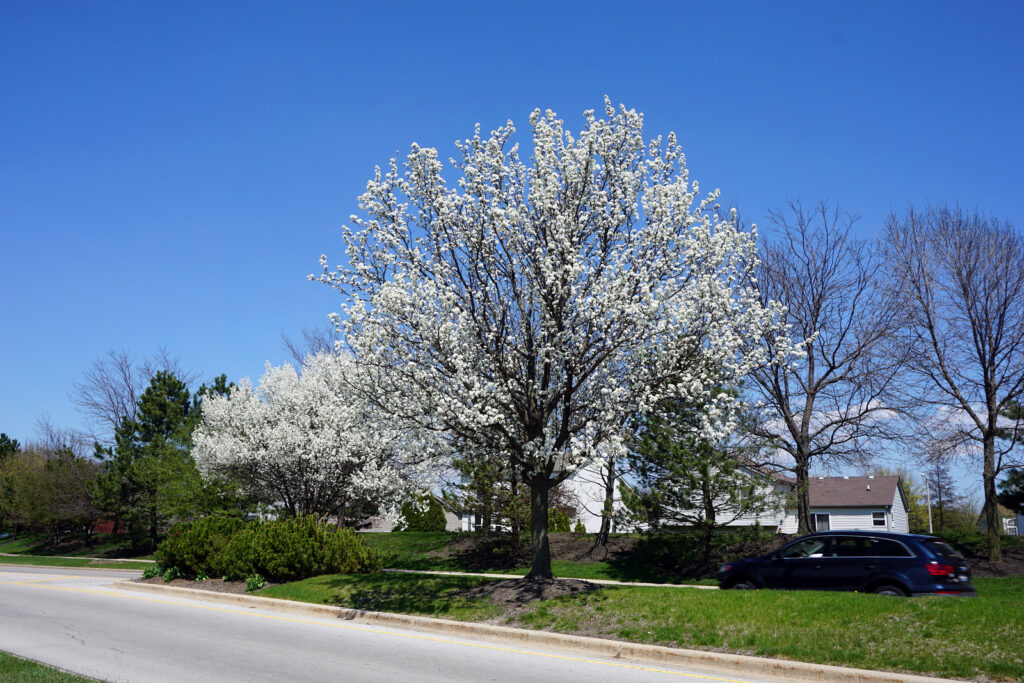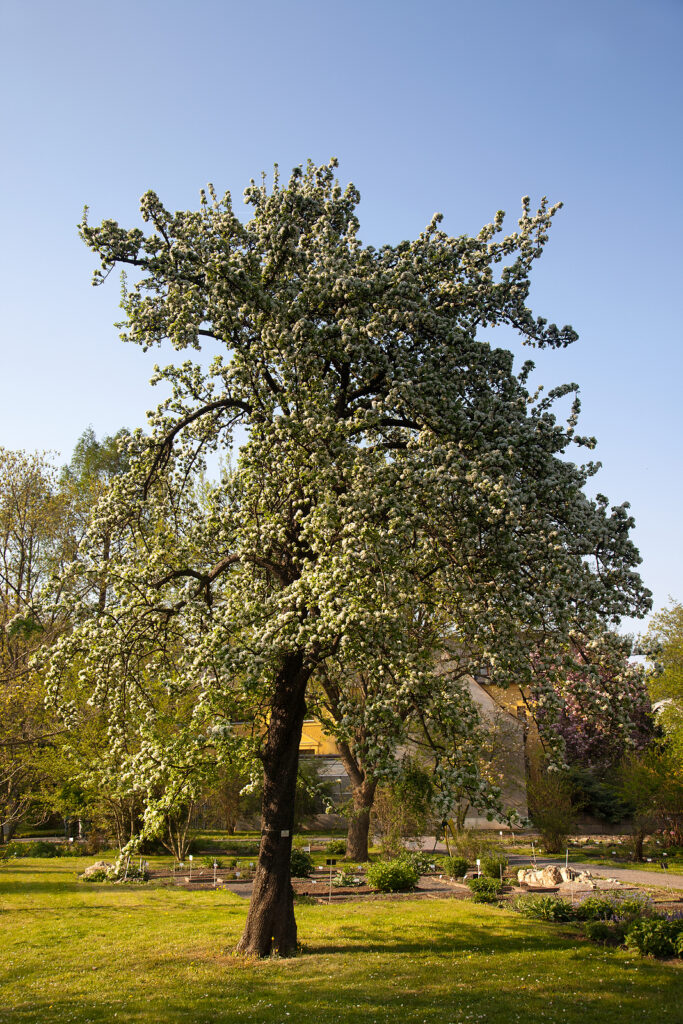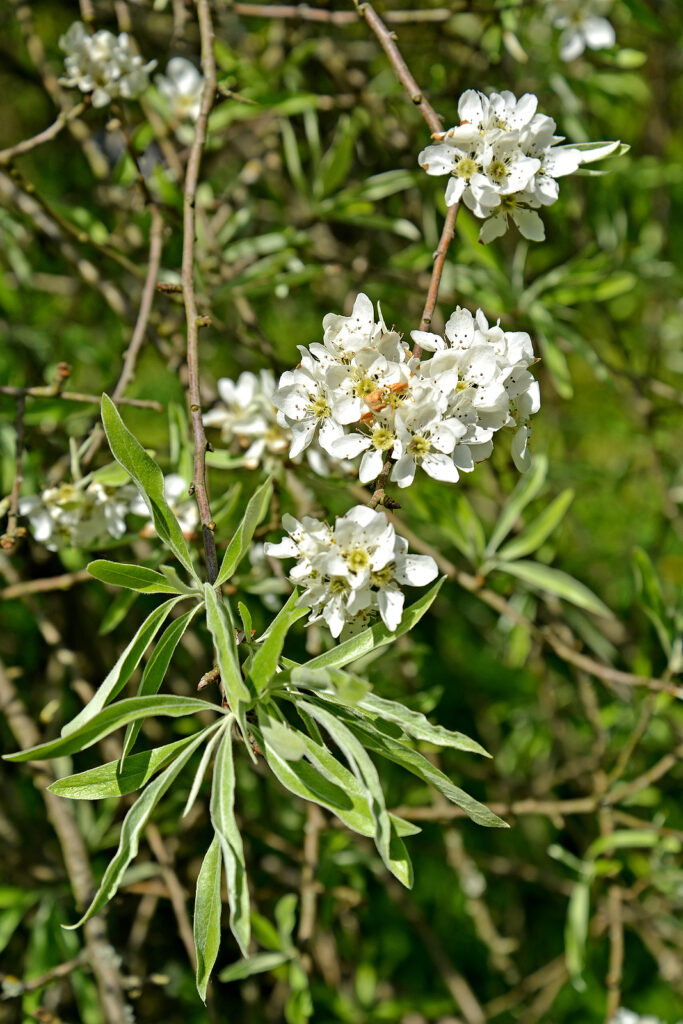Ornamental flowering pears are grown for their profuse flowers that appear in late winter and early spring.
Pyrus are medium to large deciduous trees valued for their upright form. Most grow well in tight urban or street settings although some with closely angled branches can be susceptible to wind damage if not trained or pruned.
Pyrus are relatively fast-growing trees; they reach goo size in 10 years and full maturity in another ten. Flowers appear in spring before leaves unfurl. Leaves are glossy and green from late spring to late summer. In autumn, leaves turn yellow, orange, scarlet, and purple and hold on to the trees for several weeks.
Flowering pears can be used in lawns, large planting beds as specimens. They are well suited for patios, courtyards, entries, lining driveways, and street trees. Generally, their roots are well behaved and won’t buckle paving.

Get to know Pyrus – Flowering Pear
- Plant type: Evergreen or deciduous trees or shrubs
- Growing zones and range: Zones 4 to 9
- Hardiness: Cold tolerant
- Height and width: 25 to 50 feet (7.6-15.2m) tall and wide depending on the variety.
- Foliage: Leaves are glossy ovals with toothed or scalloped edges; branches are sometimes thorny; foliage color is brilliant in fall and lasts for several weeks; autumn leaves of a single tree may include red, purple, orange, and scarlet.
- Flowers: Small clusters of white flowers in spring and usually small, seedy, inconspicuous fruits; some people find the flowers to have an unpleasant odor.
- Bloom time: Early spring
- Uses: Street tree, small to medium shade tree although somewhat narrow upright growing varieties will provide limited shade
- Common name: Flowering pear
- Botanical name: Pyrus
- Family name: Rosaceae

Where to plant Pyrus – Flowering Pear
- Grow Pyrus in full sun to partial shade.
- Grow Pyrus in average to humus-rich, well-drained soil.
- Grows well in urban settings; tolerates air pollution.
- Large limbs of some cultivars with close angle branches may be susceptible to wind and storm damage.
When to plant Pyrus – Flowering Pear
- Set container-grown plants in the garden in spring or autumn.
- Avoid transplanting trees to the garden during hot weather.
Planting and spacing Pyrus – Flowering Pear
- Space Pyrus 25 to 50 feet (7.6-15.2m) depending on the variety.
How to water and feed Pyrus – Flowering Pear
- Keep the soil evenly moist; dry soil can stress plants and leave them vulnerable to attack by pests and disease.
- Established trees can tolerate drought and intermittent wet soil.
- Feed Pyrus in spring following bloom time with an all-purpose fertilizer.

Pyrus – Flowering Pear care
- Mulch to the drip line with aged compost to help conserve soil moisture—and add nutrients to the soil.
- Large limbs of some cultivars with close angle branches may be susceptible to wind and storm damage.
- Prune trees when young to develop strong crotch angles.
- Prune established trees in late winter or early spring; remove dead, diseased, or crossing branches and prune for shape.
Pyrus – Flowering Pear pests and diseases
- Pyrus is susceptible to fire blight, especially in warm winter and hot summer regions.

Pyrus – Flowering Pear propagation
- Best course is to buy a healthy specimen from a garden center or nursery.
Pyrus – Flowering Pear varieties to frow
- Pyrus calleryana, Callery pear: Deciduous tree grows 25 to 50 feet (7.6-15.2m) tall with strong horizontal branching; glossy, dark green leathery leaves to 3 inches long; leaves turn purplish-red in autumn; clustered pure white flowers to 1 inch wide; very early bloom. Several cultivars include: ‘Aristocrat’ with pyramidal forms with branches that curve upward, less prone to trunk-splitting; ‘Bradford’ strongly vertical limbs, no central leader, grows 30 to 50 feet (9.1-15.2m) tall and 30 feet wide; ‘Capital’ narrow columnar form, coppery fall leaves, grows to 40 feet (12.1m) tall and 15 feet (4.5m) wide; ‘Chanticleer’ narrow by not columnar grows to 40 feet tall and 15 feet wide, orange to reddish-purple fall color, less susceptible to cold damage; ‘Redspire’ similar to ‘Aristocrat’ but shorter, large blossoms, yellow to red fall color; ‘Whitehouse’ narrowly columnar, free to purplish fall color.
- P. kawakamii, evergreen pear: Partially deciduous tree or shrub grows 12 to 30 feet (3.6-9.1m); masses of clustered white flowers in late winter or early spring; must be trained as a tree otherwise it will become a broad, sprawling shrub; shorten framework branches to establish tree form; if heavily pruned will not flower.
- P. nivalis, snow pear: Small tree grows 15 to 30 feet tall with upright branches that become spreading; clusters of white flowers in spring; green leaves are white and felted on the underside.
- P. pyrifolia, sand pear: Deciduous tree grows to 40 feet tall; glossy, leathery leaves; fall color is brilliant orange-red to reddish-purple.
- P. salicifolia ‘Pendula’: weeping willow-leafed pear: Deciduous tree grows 15 to 25 feet tall; silvery, willow-like foliage and beautiful weeping habit; white flowers appear in early spring as new leaves emerge; foliage turns silvery green in summer.















